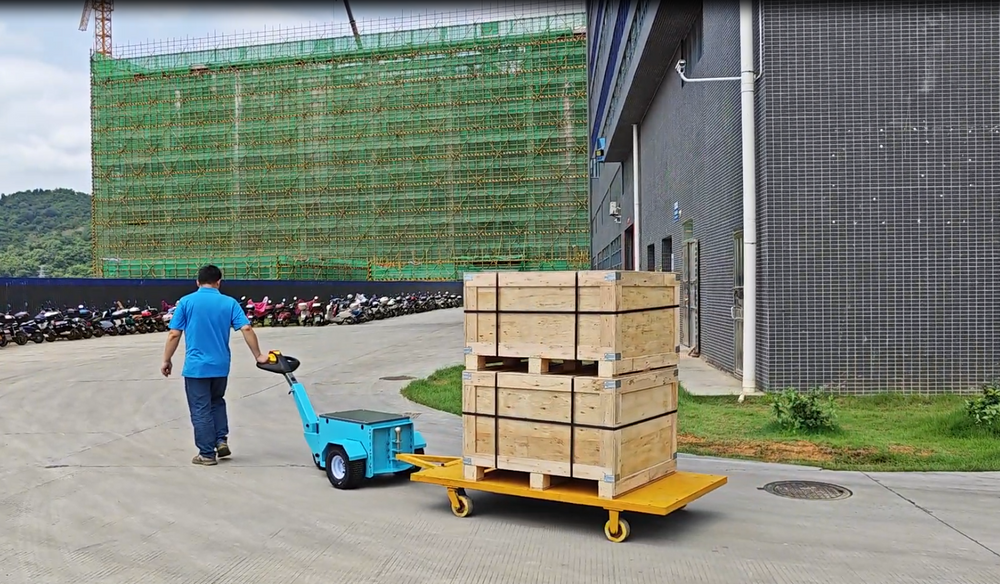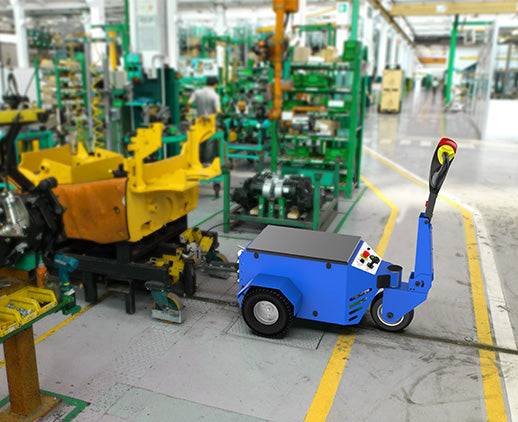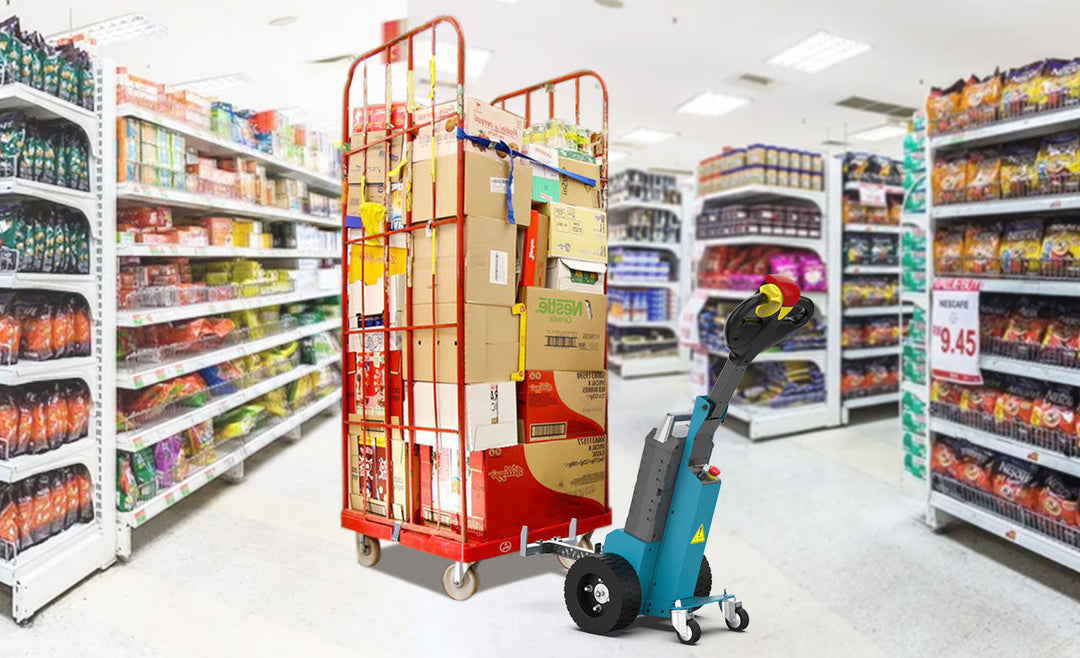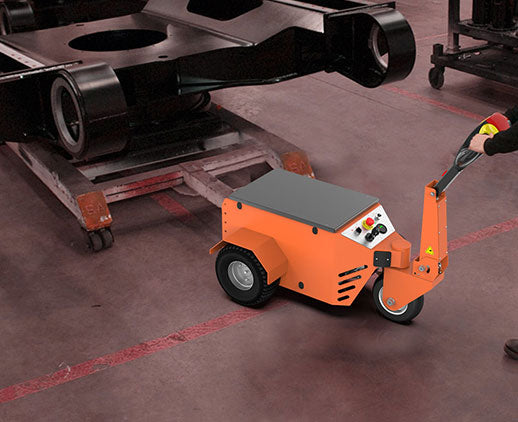Are Electric Tugs Safe for All Industries
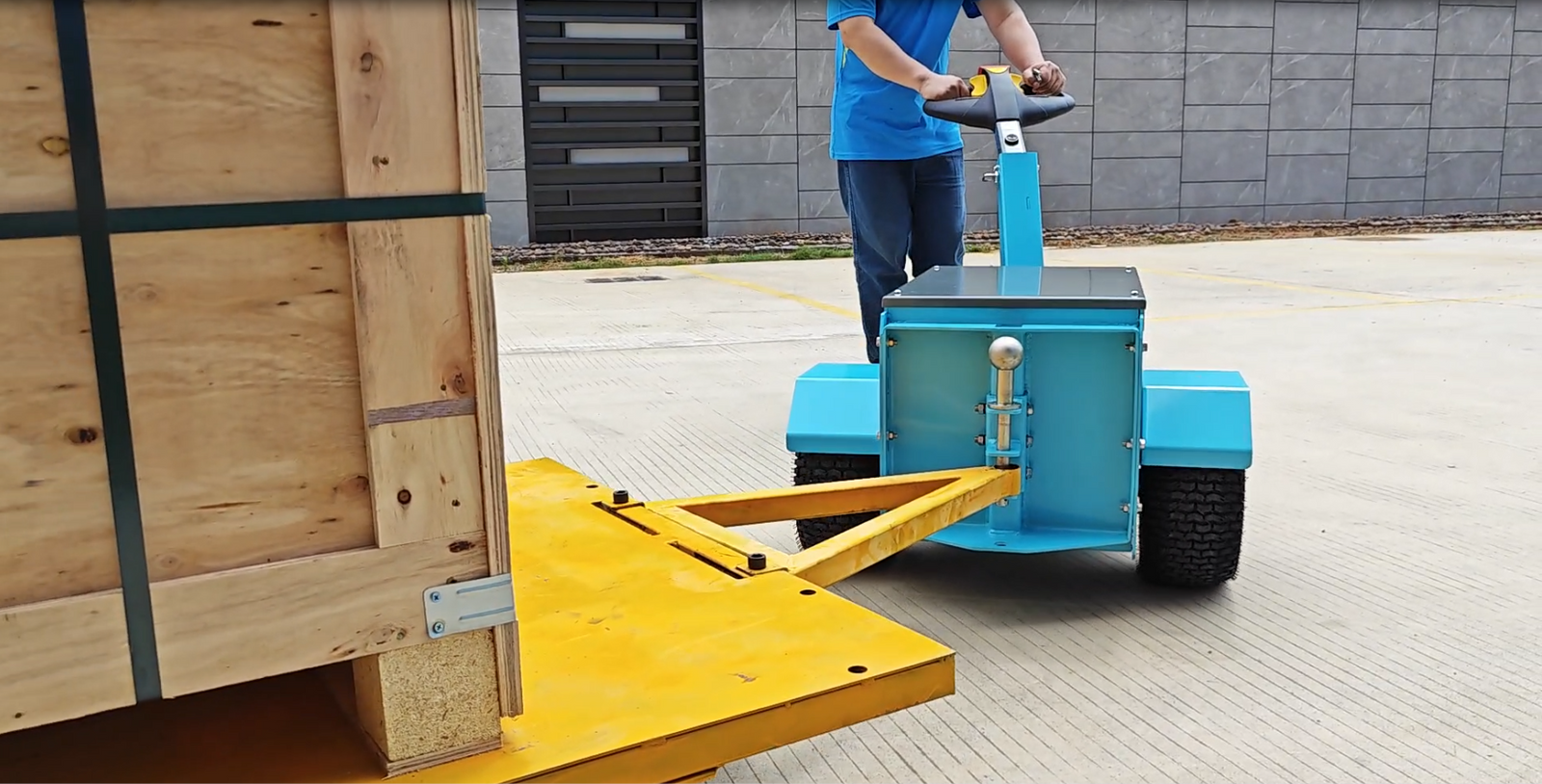
Yes, electric tugs are safe across industries, reducing accident rates by 20–30% due to their precise controls and responsive brakes. Features such as anti-slip systems, obstacle detection, and temperature-controlled batteries make them safe for operation even in extreme conditions, hence reliable for logistics, aviation, manufacturing, and waste management.
Warehouse and Logistics
Electric tuggers have a 25% lower accident rate compared to their conventional internal combustion engine counterparts, which is mainly because of their accurate operational control and responsive braking. According to one logistics company, once they had completely adopted electric tuggers, the number of safety incidents fell annually from 20 to 12.
In noisy working conditions, the noise level of internal combustion engine tuggers is normally around 75 decibels, which can easily mask other warning sounds. The operating noise of electric tuggers is only 50 decibels. Workers may not notice the approach of tuggers at visually obstructed warehouse corners. Most manufacturers have added visual and sound warning features to enhance safety, such as LED warning lights and beeping sounds.
Standard electric tuggers are able to tow loads safely from 1.5 to 3 tons. Because of their lower center of gravity, they can perform better while moving high-stacked goods compared to internal combustion engine tuggers. The tipping accident rate of electric tuggers is 15% lower than that of internal combustion engine tuggers. Feedback from a warehousing center showed that their goods transportation efficiency increased by 20%, while the rate of damaged goods decreased by nearly 10%.
Batteries face performance decline by as much as 30% at -10°C. Some companies use temperature-controlled functions in their batteries and thus keep this range of the level of endurance decline to below 10%, effectively minimizing probabilities of such an issue.
The laser navigation and collision sensors equipped on the electric tuggers enable them to work automatically. Slowing down or stopping by sensing real-time distance to obstacles can lower the rate of safety accidents by 30%.
Poor batteries or unnormalized charging may lead to overheating or short circuits in some instances. A brand of electric tuggers introduced a double overload protection mechanism, and the failure rate of batteries dropped to 0.01%, which set an industry benchmark.
A regular electric tugger may bear a safe load of only 2 tons, though some enterprises tried to operate it at over 3.5 tons transportations. According to the studies carried out, in case of an overload, the braking distance of the given equipment can increase up to 20% and correspondingly raise the risks of accidents.
Aviation and Airports
Electric tuggers have been applied in aircraft towing and ground services, reducing operational accidents by about 30%. In tests, an airport found that when an electric tugger towed a 60-ton aircraft, the deviation error was only 2 centimeters, while the deviation error of traditional internal combustion engine tuggers could exceed 5 centimeters.
A typical medium-sized airport handles more than 500 flights daily. If all operations used electric tuggers, annual carbon dioxide emissions could be reduced by approximately 1,000 tons. According to research by the International Air Transport Association (IATA), reducing emissions from ground service equipment can improve airport air quality by 20%.
In the extreme cold of a Nordic airport, electric tuggers fitted with temperature-controlled batteries operated at 85% endurance when temperatures were as low as -20°C. Their combustion-driven cousins usually would not start as fuel system freezing took place. On the hot sands of the Middle East, electric tuggers automatically prevented battery overheating thanks to built-in cooling systems.
In comparison with the internal combustion engine tuggers, the low-noise advantage of electric tuggers causes minimal disturbances in the surroundings. However, this may reduce the awareness of the personnel towards the tuggers. Chances of the ground staff coming in contact with electric tuggers increased by 15% without installed warning sounds. Thus, to solve the problem, several airports use high-decibel warning sounds along with LED lights to make the electric tuggers more visible.
According to the standard of ground service equipment of aviation, electric tugger has a service life of about 8~10 years, while the traditional internal combustion equipment has a service life of 6-8 years; for maintenance cost, electric tugs would cost only a small amount, accounting for only 50% of traditional equipment. In a big airport, the electric tuggers cost about $7,000 USD per year for maintenance, while the internal combustion engine tuggers can cost up to $14,000 USD.
Modern electric tuggers are normally installed with automatic navigation and collision prevention systems that enable them to work around the aircraft with precision. These intelligent features can reduce the rate of accidents by 25%. For example, one airport managed to cut down aircraft ground towing accidents from 10 to 5 using smart electric tuggers.
A normal electric tugger is designed for a maximum towing capacity of 80 tons. For heavy cargo planes exceeding 120 tons, special designs for enhanced models may be required. Inappropriately chosen models of equipment could lead to a 20% increase in braking distance, raising safety risks.
Each electric tugger can move 10 tons of luggage per hour, which is 10% more efficient than internal combustion engine equipment. In addition, the rate of damage to luggage has fallen by 5%, further increasing customer satisfaction for airlines.
Manufacturing and Industrial Plants
Compared to the internal combustion engine tuggers, an electric tugger reduces the accident rate by 20% in high-density operating environments. Due to this, electric tuggers have stronger operational flexibility. For example, for an electric tugger, it takes only 1.2 seconds to brake, while it takes an internal combustion engine tugger 1.8 seconds to stop.
Noise emitted by traditional internal combustion engine tuggers reaches as high as 80 decibels, while that of electric tuggers is only 55 decibels. According to the survey conducted by a large manufacturing enterprise, operational errors caused by noise were reduced by 15%, while the efficiency of safety production increased by 10%.
Most of the electric tuggers used in industry can safely move 3 to 5 tons of materials, with about 12% higher rated power output stability compared with tuggers propelled by internal combustion engines. For instance, a certain automobile manufacturing plant has represented the point that hourly material transportation efficiency was increased by about 18% since shifting to electric tuggers.
The fuel system of the traditional equipment may fail in an extremely high-temperature working condition, while the cooling system of the batteries of electric tuggers can maintain the temperature within the safe range for avoiding accidents. While working under extremely low temperatures, electric tuggers with temperature-controlled batteries can preserve more than 90% endurance, but the traditional equipment usually cannot work due to the frozen fuel.
Although conventional internal combustion engine equipment can emit up to $70,000 annually in a typical medium-sized industrial plant, electric tuggers are capable of reducing this figure to zero. Long-term studies in plants using electric tuggers showed that the incidence of diseases of the respiratory system among employees decreased by about 8%.
The annual maintenance cost for a traditional internal combustion engine tugger is about $2,800, while the electric tugger's is only $1,400. One mechanical manufacturing plant reported that with the introduction of electric tuggers, the saving of equipment maintenance costs reached $42,000 annually, equivalent to increasing the profit margin by 2%.
Modern electric tuggers are installed with laser navigation systems and automatic collision prevention features that can detect obstacles in their path and automatically decelerate or stop. In a study involving 100 manufacturing enterprises, it was found that these intelligent features reduced the accident rate of tuggers by 30%. For instance, in an electronics manufacturing plant, six collision incidents were reduced annually by deploying automated electric tuggers.
In investment terms, the electric tuggers are some 20% more expensive than internal combustion engine tuggers; with savings in fuel and maintenance costs during long-term use, however, the return on investment period is shortened to 2–3 years. In one heavy industry enterprise, the use of electric tuggers saved about $70,000 in annual operating costs.
Retail and Supermarkets
Compared to the traditional ones, electric tuggers reduce the accident rate by about 20% when working in a high-frequency operation environment. The merits mainly come from the lower operation noise and more sensitive braking system; its average braking response time is 1.5 seconds, 0.5 seconds shorter than that of the internal combustion engine tuggers.
The common models can pull 1.5 to 2 tons of cargo, which meets the demand for replenishment in most supermarkets. Data from a large chain supermarket shows that since adopting electric tuggers, hourly goods transportation volume has increased by 15%, with shelf replenishment efficiency having improved by 10%.
While working, electric tuggers can attain noise levels equivalent to a common speech at 55 decibels, while classic models running on an internal combustion engine might attain 75 decibels.
Traditional internal combustion engine tuggers emit carbon dioxide and other harmful gases during operation, while electric tuggers achieve zero emissions. According to an industry study, a large supermarket of 10,000 square meters can reduce about 50 tons of carbon dioxide emissions annually by using electric tuggers.
Now, with the obstacle detection and automatic deceleration, a modern electric tugger can execute quick stops when shelves or personnel get in the way. Statistics from a large retail enterprise showed that accident rates in internal logistics went down by 30% with the introduction of these features, providing a much safer environment for customers and employees.
The procurement cost for an electric tugger is about 25% higher than traditional equipment, but their economic benefits long-term have been convincing. A mid-size chain supermarket estimated that, comparatively, an electric tugger's annual maintenance cost is half that of conventional models and energy costs are cut by about 40%.
Safer to operate - With a low center of gravity design and electronic stability control system, an electric tugger reduces tipping accident rates when moving high-stacked goods by up to 15% compared to using internal combustion engine equipment.
Healthcare and Hospitals
Compared to the accident rate of traditional equipment driven by an internal combustion engine, electric tuggers reduce the accident rate in medicine, equipment, and even hospital bed transportation by 30%. Statistics from a certain hospital show that since changing over to electric tuggers, the number of collision incidents during transportation reduced from $1.4 per month to $1.0, hence greatly improving the safety of internal logistics.
Traditional internal combustion engine tuggers usually generate between 70 and 80 decibels of operating noise, whereas electric tuggers generate only 50 to 55 decibels, which is equivalent to normal conversation volume. According to one large medical center, the use of low-noise equipment improved patient satisfaction with the environment by 15% and reduced nurses' operational error rates by 8%.
Most electric tuggers used in hospitals have load capacities of 500 kilograms to 1 ton, sufficient for transporting most medical equipment and supplies. Data from a large hospital shows that electric tuggers can complete 30 material transport tasks per hour, 20% more efficient than traditional equipment.
Modern electric tuggers are commonly equipped with anti-slip systems, ensuring stable operation on slippery surfaces. A hospital reported that after installing anti-slip devices, accidents caused by slippery floors during transportation decreased by 40%. Electric tuggers' automatic navigation technology allows them to operate along preset paths, reducing reliance on manual operation.
An electric tugger can run 8 to 10 hours on one charge and thus fully covers most of the daily transportation tasks in hospitals. Reports from a tertiary hospital say that with fast-charging equipment, the battery replacement time was shortened to about 5 minutes, which greatly improved efficiency.
In terms of the cost, although the procurement cost of an electric tugger is 20% to 30% higher than that of a traditional one, the operational cost is far lower. Statistics from a hospital show that the average annual maintenance cost for electric tuggers is $500, while for traditional internal combustion engine equipment, it is over $1,000. Meanwhile, energy costs for electric tuggers are 40% lower than for traditional equipment, bringing great long-term economic benefits.
Automotive Industry
Electric tuggers have an accident rate 25% lower than that of traditional internal combustion engine tuggers. The main reason is that electric tuggers have more precise control systems, with a braking response time of 1.2 seconds, about 0.6 seconds faster than traditional tuggers.
It has the added capability of tugging 2 to 3 tons of automotive parts. In a big automobile manufacturing plant, for instance, there were over 200 batches transported daily, totaling 400 tons, thereby increasing efficiency by 15% compared to using internal combustion engine tuggers. On top of this, the damage rate of the goods in transit was reduced by 10%.
Traditional internal combustion engine tuggers have very high noise levels, as high as 75 to 85 decibels; electric tuggers can only create 55 decibels of noise, which is the equivalent to normal conversation. According to an automotive enterprise survey, the low-noise equipment increased employee productivity by 12% and reduced production line downtime by 5%.
Traditional tuggers emit 2.7 kgs of carbon dioxide every hour, while electric tuggers produce zero emissions. Once a large automobile enterprise reported that using electric tuggers decreases carbon emissions by $145,000 yearly, which equates to the greening of 50,000 trees.
Data from one automobile manufacturing plant testifies that even at such low temperatures as -10°C, electric tuggers lost only 10% of their endurance, while traditional internal combustion engine tuggers often failed to operate because of fuel system problems.
The modern electric tuggers also come fitted with collision sensors and laser navigation systems that provide for automatic deceleration or full stop when obstacles are detected. In one automotive parts factory, these intelligent features reduced workshop accident rates by 35%.
The average price for a single electric tugger is about $14,000, which is 30% higher than that of internal combustion engine tuggers with the same specification. However, a car factory claimed that its annual maintenance cost for electric tuggers was $700, while that of internal combustion engine tuggers was $2,100. Besides, electric tuggers save about 40% in annual energy consumption.
Automotive manufacturing production lines have to tug their components to pre-positioned points with millimeter-level precision. Statistics show that for one high-end automotive manufacturing enterprise, the electric tuggers improved its assembly efficiency by 18%, while rework costs resulting from positioning errors decreased accordingly.
Electric tuggers can operate continuously for 8 to 10 hours on one charge. For factories that require 24-hour operations, back-up batteries and fast-charging technology provide reliable support. Some enterprises have introduced quick-charging equipment, reducing the charging time to within 30 minutes.
Public Service and Waste Management
It has been the result that electric tuggers have an accident rate 25% lower than traditional internal combustion engine equipment in performing waste transport tasks, due to the accuracy of maneuverability and the promptness of the braking system, whose response time is 1.5 seconds, or 0.5 seconds more compared with internal combustion engine tuggers.
Standard electric tuggers can tow 3 to 5 tons of waste safely and fully meet most urban waste management tasks. According to the data of a municipal waste management agency, using electric tuggers has increased the waste transportation volume per hour by 20% with a reduction of 15% in equipment failure rates.
One of the major advantages of electric tuggers in public service is low-noise operation. Conventional internal combustion engine tuggers emit noise levels up to 80 decibels, whereas electric tuggers work at just 55 decibels, equal to normal conversation. Waste collecting companies in some cities reported a 30% decrease in noise complaints from residents.
Internal combustion engine equipment can emit as much as 2.5 kilograms of carbon dioxide every hour, while electric tuggers do not create such pollution at all. The complete transition to electric tuggers for refuse transport in a medium-sized city, according to one environmental agency, would cut carbon dioxide emissions by 5,000 tons a year, the equivalent of planting 250,000 trees.
Modern electric tuggers are normally equipped with obstacle detection and automatic braking to allow them to automatically stop in case of detection of personnel or obstacles ahead. In a study involving 50 urban waste management projects, it was observed that these intelligent features cut down the accident rates by 35%.
At low temperatures, as low as -10°C, electric tuggers fitted with temperature-controlled batteries retain up to 90% of their endurance, while many traditional internal combustion engine units fail to start because the fuel system is frozen. Correspondingly, during high-temperature conditions, electric tuggers have effective cooling systems to prevent overheating problems.
A fully charged electric tugger can work for 8 to 10 hours uninterruptedly. One city promoted fast-charging equipment, shrinking the battery replacement time to 5 minutes and greatly improving equipment utilization.
Although the procurement cost of an electric tugger is about 30% higher than traditional equipment, the operational cost in the long run is much lower. The annual maintenance cost for an electric tugger is $500, while internal combustion engine equipment costs $1,500. Electric tuggers save about 40% in annual energy costs. According to data from a waste management company, the adoption of electric tuggers saved almost $150,000 in annual operating costs.
Electric tuggers are of a low center of gravity design and electric drive, which can effectively avoid container tipping in transport, thus reducing secondary pollution. According to the feedback from waste management companies, there was a 15% reduction in environmental incidents related to container tipping after the introduction of electric tuggers.




